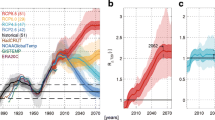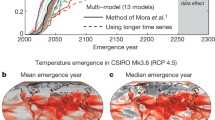Abstract
Anthropogenic greenhouse gas emissions that induce changes in the Earth’s climate affect particular variables and locations differently. A key part of this difference is the timescale at which this change takes place, which will eventually have important consequences for adaptation requirements. This idea of timescale associated with climate change has been used several times in the past to estimate the urgency of adaptation in particular regions. The definition of climate-change timescale is, however, not unique. For example, we can think of it in terms of an expected trend (e.g. in temperature) reaching a given threshold, or think of it in terms of the time it may take this trend to become statistically significant. We may also wonder about the validity of this speculation given that, due to natural variability, the expected trend may in fact not be realized. In this article we explore alternative ways of defining the timescale of climate-change, compare their properties, and illustrate them with an example for the case of projected surface temperature over North America. It is shown that these timescales are analytically related but may differ substantially in magnitude under certain conditions. In particular, it is shown that climate change impact on vulnerable systems may arrive before statistical detection of the variable’s trend takes place. This fact may have implications on how climate change impacts are seen by those with diverging interests.




Similar content being viewed by others
References
Collins M, Knutti R, Arblaster J et al (2013) Long term climate change: projections commitments and irreversibility. In: Stocker TF et al (eds) Climate change 2013: the physical science basis. Contribution of working group I to the fifth assessment report of the intergovernmental panel on climate change. Cambridge University Press, Cambridge and New York
de Elia R, Biner S, Frigon A (2013) Interannual variability and expected regional climate change over North America. Clim Dyn. doi:10.1007/s00382-013-1717-9
Deser C, Knutti R, Solomon S, Phillips AS (2012) Communication of the role of natural variability in future North American climate. Nat Clim Chang 2:775–780
Giorgi F, Bi X (2009) Time of emergence (TOE) of GHG-forced precipitation change hot-spots. Geophys Res Lett 36:1–6
Hallegatte S (2008) A note on including climate change adaptation in an international scheme. n°18, IDDRI -Idées pour le débat 1–15
Hawkins E, Sutton RT (2009) The potential to narrow uncertainty in regional climate predictions. Bull Am Meteorol Soc 90:1095–1107
Hawkins E, Sutton RT (2012) Time of emergence of climate signals. Geophys Res Lett 39:1–6
Jones RN, Mearns LO (2005) Assessing future climate risks. In: Lim B, Spanger-Siegfried E, Burton I, Malone E, Huq S (eds) Adaptation policy frameworks for climate change: developing strategies, policies and measures. Cambridge University Press, Cambridge and New York, pp 119–144
Liebmann B, Dole RM, Jones C, Bladé I, Allured D (2010) Influence of choice of time period on global surface temperature trend estimates. Bull Am Meteorol Soc 91:1485–1491. doi:10.1175/2010BAMS3030.1
Loarie SR, Duffy PB, Hamilton H, Asner GP, Field CB, Ackerly DD (2009) The velocity of climate change. Nature 462:1052–1055. doi:10.1038/nature08649
Maraun D (2013) When will trends in European mean and heavy daily precipitation emerge? Environ Res Lett 8:014004. doi:10.1088/1748-9326/8/1/014004
Matsuura K, Willmott CJ (2009) Terrestrial air temperature and precipitation monthly time series (1900–2008) version 2.01 released June 2009. Available online at http://climate.geog.udel.edu/~climate/
Mearns LO, Sain SR, Leung RL et al (2013) Climate change projections of the North American Regional Climate Change Assessment Program (NARCCAP). Clim Chang. doi:10.1007/s10584-013-0831-3
Mora C, Frazier AG, Longman RJ et al (2013) The projected timing of climate departure from recent variability. Nature 502:183–187
Wilks DS (2006) Statistical methods in atmospheric sciences, 2nd edn. Elsevier, p 627
Acknowledgments
The authors wish to thank the North American Regional Climate Change Assessment Program (NARCCAP) for providing the data used in this paper. NARCCAP is funded by the National Science Foundation (NSF), the US Department of Energy (DoE), the National Oceanic and Atmospheric Administration (NOAA), and the US Environmental Protection Agency Office of research and development (EPA). The authors also want to thank the editor and the reviewers, especially one of them, who contributed considerably to the improvement of the manuscript.
Author information
Authors and Affiliations
Corresponding author
Appendices
Appendix A: Alternative definitions of detection timescale
Trend detection is a complex problem that has been the center of many studies. A variety of methodologies with different levels of complexity exist that adapt to different problems and it is not uncommon to tackle one issue with more than one method (see for example Liebmann et al. 2010). The EYE index introduced in de Elia et al. (2013) and used here, takes advantage of the simplicity of the formulation for trend detection derived from linear regression. This simplicity naturally has a down side; for example, our assumption of independence between successive values is not fully met. Hence, our estimation of the detectability timescale provides us with the lower boundary of the possible estimations, that is, when time series in fact have a complex autocorrelation function the real timescale will be larger than predicted here.
In addition to trends derived from linear regression, there are other simple ways to detect a trend’s presence, and each way is associated with its own detection timescale. A question that naturally arises is how these detection timescales relate to each other. In order to partially answer this question, two alternative ways of estimating trends will be evaluated following the same criteria as those employed in the development of the EYE index.
1.1 A.1 Two separate time windows
In climate research, a common way to study the existence of a trend is by considering two separate time windows, usually of 30 years each. The evolution of a variable between two time windows of length m can be obtained using the Student’s t-test for mean values (e.g. Wilks 2006). Assuming, as in the case of the EYE index, a linear trend embedded in an uncorrelated time series of yearly values with a stationary Gaussian distribution, we can isolate the expected number of years n over which a change in the mean can be detected. Assuming the situation described in Fig. 1b, we can write a Student t-test for the difference of means as
where the numerator represents the difference of means between time windows, and the denominator contains the time standard deviation (assuming equality for both time windows for the sake of simplicity) and the number of years m in each window. Using the terminology described in Fig. 1b we can rewrite (A.1) as
where N is the number of intervening years between windows. Substituting for N the total number of years needed to obtain this significant difference of the means, n = N + 2 m, in other words, the total number of years involved in the evaluation, and isolating this last we obtain
As we can see, this formulation differs substantially from that related to EYE (expression (2) of main section). Figure 5 illustrates how this timescale is affected by SNR and how it compares with the previous developments.
Climate change timescales as a function of SNR. The solid black line indicates the vulnerability timescale for r = 1. The solid red line indicates the detection timescale based on the EYE index. The dashed black line indicates the detection timescale for two separate time windows of 30 years. The dotted black line indicates the detection timescale for two contiguous time windows. The three detection timescales are drawn for a 95 % level of confidence
1.2 A.2 Two contiguous time windows
An alternative to using two time windows of a given size is to define two contiguous windows that utilize the entire dataset (see Fig. 1c). Using the same approximations as in the previous case we can write that
Replacing m with the total number of years needed to do this test, n = 2 m, and isolating this last we obtain
This expression is identical to that of the EYE index presented in (2),with the exception of the multiplicative factor. Figure 5 shows this timescale compared with those defined earlier. It is worth noting that among detection timescales, the EYE index consistently produces the shortest timescale (see red line). This is the reason why it was chosen as the main detection timescale in this work.
Appendix B: Interval of confidence for the vulnerability and detection timescales
In this appendix an evaluation of the confidence interval is carried out for the two timescales discussed in the main text (sections 2.1 and 2.2).
2.1 B.1 Stochasticity in the trend
For the case of the vulnerability timescale (section 2.1), time variability’s only role is to give a sense of the magnitude of the displacement of the mean. Relative changes with respect to time variability are commonly used with this objective. For the case of the detection timescale (section 2.2), variability over time is thought of as an obstacle to accurately estimating a trend. Hence, for detecting a given a trend we may ask ourselves how many years of noisy data are needed to achieve statistical significance. We should keep in mind however, that thus far we have assumed our trend is that projected by an ensemble of climate models.
The cases discussed in section 2.4 and in what follows also take into account the fact that the realized trend may not be the expected one–a consequence of having a signal imbedded in noise. It allows for the trend β to be a random variable with Gaussian distribution centered on the expected value–the one projected by climate models–and standard deviation σ β , which is a function of the length of the time window considered.
2.2 B.2 Interval of confidence for the vulnerability timescale nr
Let us assume that our vulnerability timescale is defined as in (1). Recalling that the standard deviation of the trend β under the assumptions described in section 2.2 can be written as
as discussed in de Elia et al. (2013). From B.1 we obtain:
Isolating n it follows that
We can estimate the variance of the right hand side of this expression as
And, taking advantage of the assumption that the distribution of the trend β is Gaussian, the variance on the right-hand side becomes equal to one. We can then write
We can construct intervals of confidence for n 1/2 ± σ, obtaining
This expression can be used to obtain an estimate of the confidence interval for n,
It should be noted that this transformation does not allow us to consider it an interval of confidence of n ± σ in the new variable, although the interval does represent the same quantiles, covering 68 % of the distribution.
2.3 B.3 Prediction interval for EYE index
Following the developments of de Elia et al. (2013), we can obtain the prediction interval for the EYE index by defining a range for the signal in terms of its estimation error so that
From here it can be easily shown using the same procedure as in de Elia et al. (2013) that
Assuming that α = 5 % (t ~ 2) it follows that the prediction interval can be simply written as
Rights and permissions
About this article
Cite this article
de Elía, R., Biner, S., Frigon, A. et al. Timescales associated with climate change and their relevance in adaptation strategies. Climatic Change 126, 93–106 (2014). https://doi.org/10.1007/s10584-014-1209-x
Received:
Accepted:
Published:
Issue Date:
DOI: https://doi.org/10.1007/s10584-014-1209-x





